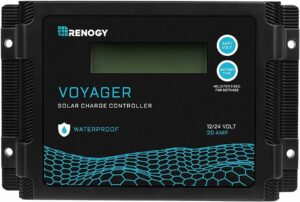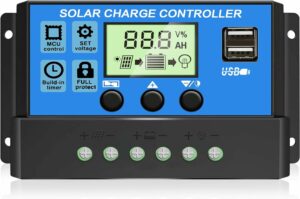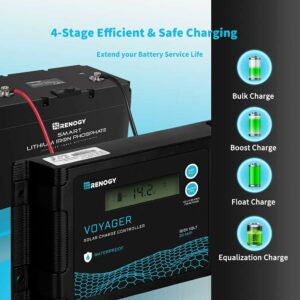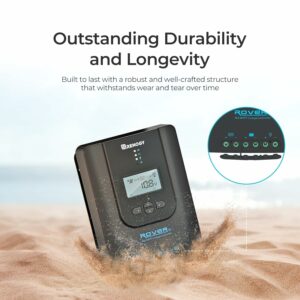
Renogy New Edition Voyager PWM Waterproof Solar Charge Controller
RV Solar Charge Controller Upgrade
Introduction
RV Solar Charge Controllers are crucial for solar power systems for recreational vehicles (RVs).
These devices play a vital role in regulating the flow of electricity from solar panels to the RV’s battery bank.
The primary purpose of an RV Solar Charge Controller is to prevent overcharging and ensure the optimal charging of batteries, thereby maximizing the efficiency and lifespan of the entire solar power system.
Provo Green Products embodies a beacon of trust in sustainable discoveries, offering choices that enhance your life and leave a positive mark on our planet.
Leveraging extensive expertise in manufacturing, construction, and various trades, we provide a solid foundation for sustainable living.
Our meticulous research process guarantees that our information about each product is precise and current, allowing you to make informed decisions.
Whether your interest lies in solar products, electric bikes, or other eco-friendly alternatives, our commitment to credibility ensures you have access to dependable insights, guiding your journey toward a more sustainable lifestyle.
Provo Green Products is your go-to destination for finding the right green products for your lifestyle.
Disclosure: We may earn a small commission if you click on one of our links. This will not affect the pricing of the product whatsoever.
Types of RV Solar Charge Controllers
PWM (Pulse Width Modulation) Controllers:
- Operating Principle: PWM controllers regulate the voltage by rapidly switching the solar panels on and off. This modulation maintains a consistent voltage level, preventing overcharging of the batteries.
- Suitability: Ideal for smaller solar setups and budget-conscious RV owners.
- Efficiency: While efficient, PWM controllers are slightly less so compared to MPPT controllers, especially in situations with varying light conditions.
MPPT (Maximum Power Point Tracking) Controllers:
- Operating Principle: MPPT controllers dynamically adjust the electrical operating point of solar panels to extract the maximum power. This results in more efficient energy harvesting compared to PWM controllers.
- Suitability: Suited for larger RV solar installations and areas with varying light conditions.
- Efficiency: MPPT controllers excel in converting solar energy into usable power, making them a preferred choice for many RV enthusiasts.
Hybrid Controllers:
- Combining Technologies: Hybrid controllers combine features of both PWM and MPPT technologies, offering a middle ground for those seeking a balance between cost and efficiency.
- Adaptability: These controllers can adapt to changing light conditions, making them versatile for different RV solar setups.
- Optimal Performance: While not as efficient as MPPT controllers, hybrids perform better than PWM controllers in diverse environments.
Understanding the distinctions between PWM, MPPT, and hybrid controllers allows RV owners to make informed decisions based on their specific needs, budget constraints, and the geographical diversity of their travels.
Each type has its strengths, making it crucial for RV enthusiasts to choose the one that aligns best with their energy requirements and usage patterns.

Key Features to Consider
Voltage Compatibility:
- System Voltage: Ensure that the solar charge controller is compatible with the voltage of your solar panel array and battery bank. Common voltages include 12V, 24V, and 48V systems.
Amperage Capacity:
- Matching Capacity: Select a charge controller with an amperage capacity that matches or exceeds the maximum current output of your solar panels. This ensures efficient energy transfer without overloading the controller.
Temperature Compensation:
- Temperature Sensor: Opt for controllers with temperature compensation features. These controllers adjust charging parameters based on temperature fluctuations, optimizing charging efficiency and battery lifespan.
LCD Display and Monitoring:
- User-Friendly Interface: Look for controllers with LCDs that provide real-time information on solar production, battery status, and system performance.
- Monitoring Capabilities: Some controllers offer remote monitoring capabilities, allowing you to track your RV’s solar system performance via mobile apps or online platforms.
Load Output and Dusk-to-Dawn Operation:
- Load Output: Controllers with dedicated load terminals allow you to power DC loads directly, enhancing system flexibility.
- Dusk-to-Dawn Operation: Some controllers have a dusk-to-dawn feature, enabling them to control connected loads automatically based on ambient light levels.
Considering these key features ensures that your RV Solar Charge Controller is compatible with your system and has functionalities that enhance its overall performance and user experience.
As technology advances, newer controllers may come with additional features, so staying informed about the latest solar charge controller technology developments is worthwhile.

Installation and Wiring Guidelines
Mounting Considerations:
- Secure Mounting: Install the charge controller in a secure and well-ventilated location, preferably close to the battery bank. Ensure it is mounted on a sturdy surface to handle vibrations and movement typical in RV travel.
- Temperature Considerations: Avoid exposing the controller to extreme temperatures. If possible, choose a shaded location to prevent overheating.
Connecting Solar Panels to the Controller:
- Correct Wiring: Follow the manufacturer’s guidelines for connecting solar panels to the charge controller. Pay attention to proper polarity and ensure all connections are secure.
- Sizing Wires: Use appropriately sized wires to minimize voltage drop and ensure efficient power transfer. Larger wire gauges may be required for longer cable runs.
Battery Connections:
- Proper Polarity: Connect the charge controller to the battery bank with the correct polarity. Observing the correct connection sequence is crucial to prevent damage to the controller.
- Fuse Installation: Fuse or circuit breakers on both the positive and negative battery leads to protect the system from overcurrent situations.
Connection to DC Loads:
- Load Terminals: If the charge controller has load terminals, connect DC loads directly to these terminals. Ensure that the total load does not exceed the controller’s rated capacity.
- Dusk-to-Dawn Loads: If utilizing the dusk-to-dawn feature, connect loads that must operate automatically based on ambient light conditions.
System Testing:
- Functionality Check: After wiring, perform a thorough functionality check. Ensure that the solar panels charge the batteries and that the controller properly regulates the charging process.
- Monitoring System Performance: Use the controller’s display or monitoring tools to track system performance. Adjust settings as needed to optimize charging efficiency.
By following these installation and wiring guidelines, RV owners can ensure a safe and efficient setup for their solar charge controllers.
Also, consulting the manufacturer’s instructions and guidelines specific to the chosen controller model is essential for a successful installation.
Maintenance Tips and Troubleshooting
Regular Inspections:
- Visual Checks: Conduct regular visual inspections of the charge controller, looking for signs of physical damage, loose connections, or corrosion.
- Cleanliness: Keep the controller and its surroundings clean from dust, debris, and other contaminants affecting performance.
Cleaning and Protection Measures:
- Solar Panel Maintenance: Regularly clean the solar panels to maximize energy production. Dirty panels can reduce efficiency.
- Weather Protection: Ensure the controller is adequately protected from the elements, especially in harsh weather conditions. Consider using weatherproof enclosures or covers.
Battery Maintenance:
- Voltage Levels: Monitor battery voltage levels regularly to ensure they are within the recommended range. Charge controllers often display battery status, aiding in monitoring.
- Water Levels: Check and maintain proper water levels per the manufacturer’s recommendations for lead-acid batteries.
Common Issues and Solutions:
- Overcharging: Check the settings and ensure the voltage parameters are correctly configured if the controller indicates overcharging. Adjust settings as needed.
- Undercharging: Verify the solar panel output and connections if batteries are not charging sufficiently. Adjust tilt angles or clean panels if necessary.
- Faulty Display: If the controller’s display malfunctions, check the power supply, connections, and internal fuses. Replace or repair as needed.
Extending the Lifespan of RV Solar Charge Controllers:
- Temperature Control: Ensure proper ventilation and temperature control to prevent overheating. Some controllers have built-in temperature sensors for automatic adjustments.
- Quality Components: Invest in high-quality components for your solar power system, including the charge controller, to enhance longevity.
- Firmware Updates: Stay informed about firmware updates provided by the manufacturer. Updating the firmware can address bugs and improve overall performance.
By incorporating these maintenance tips and troubleshooting strategies, RV owners can proactively address issues, maximize the lifespan of their solar charge controllers, and ensure a reliable and efficient power supply during their travels.
Regular attention to the system’s health can significantly contribute to a trouble-free solar experience.

Conclusion
Selecting the right RV Solar Charge Controller is paramount for optimizing energy efficiency and extending the life of the entire solar power system.
With considerations such as voltage compatibility, amperage capacity, and temperature compensation, RV enthusiasts can make informed choices.
Following proper installation and wiring guidelines and routine maintenance and troubleshooting measures ensure a reliable and sustainable power source for the mobile lifestyle.
Embracing these practices enhances the overall performance of RV solar setups, providing a greener and more self-sufficient energy solution.
Stay in Touch!
I’am a dedicated entrepreneur with many years of experience and an integrity-driven individual who is highly motivated to succeed. Leveraging extensive expertise in manufacturing, construction, and various trades, we can provide a solid foundation for sustainable living. Our meticulous research process guarantees that our information about each product is precise and current, allowing you to make informed decisions. A deep understanding of business operations empowers me to consistently implement improvements that result in ongoing success. Visit site.

